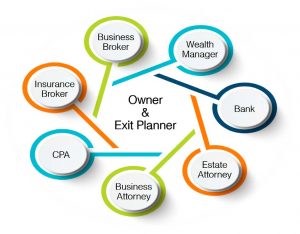Quarterbacking is a popular term when exit planners are talking to clients. It’s supposed to invoke a vision of someone who is in control. Think about a Tom Brady, Aaron Rodgers or Patrick Mahomes standing tall in the pocket, surveying the offense and defense unfolding before him.
There is a real problem with using “Quarterbacking” when referring to your exit planning professional team. The quarterback calls the plays. The job of the rest of the team is to run them as instructed. I’ve yet to meet a CPA or attorney who thinks that is the best way to develop a client’s exit plan.
Teamwork
Exit planning, like no other form of professional consulting, is a team sport. When I am engaged by a client, I have the responsibility of defending his or her long-term objectives. The other advisors, who may include an insurance agent, financial planner, or appraiser, all have experience to lend to the process.
We can modify a plan multiple times and in many ways. The accountant may have some excellent restructuring ideas to save taxes. The attorney can add terms to a buy/sell agreement to protect the owners from having their equity unfairly valued by the IRS, or from having it pass to parties outside the company.
The insurance agent can mitigate the risk of illness or death derailing the timely transfer of the business, or of the surviving family being left destitute. The appraiser can develop valuations that take advantage of the discounts permitted under IRS guidelines.
Each of these professionals has a role, and should be able to add their skills to the process, with only one exception. They should not be permitted to do anything that interferes with the owner’s objectives. That’s the responsibility of the exit planner.
The Alternative to Quarterbacking
I prefer to think of the exit planner’s role as analogous to that of an orchestra conductor.
 The exit planner may not be as skilled in any specific discipline as the others on the team. He may know something about tax planning, or legal structuring or insurance. She probably knows a bit about valuation and even more about contracts.
The exit planner may not be as skilled in any specific discipline as the others on the team. He may know something about tax planning, or legal structuring or insurance. She probably knows a bit about valuation and even more about contracts.
But, like the conductor, he or she doesn’t know more about any of those subjects than the advisor who spends full-time in that area.
No one expects the conductor to step off the podium for a violin solo, or to fill in for the French Horn. In fact, you don’t even want the conductor to tap the triangle for that one little note in the pause. If he did, he would be distracted from his primary role of keeping all the musicians on the same page.
Having one advisor coordinate the contributions of others greatly improves the overall result. Expecting him or her to dictate details outside his area of expertise is foolish. Expect your exit planner to lead without quarterbacking.

 The act doesn’t provide Boomers with additional benefits. Instead, it gives them the chance to pay more into the system. Here are the major changes.
The act doesn’t provide Boomers with additional benefits. Instead, it gives them the chance to pay more into the system. Here are the major changes.
 At one end of the spectrum we’ll say you want to exit the business in the next thirty to sixty days. That’s probably enough time to draw up a purchase agreement and transfer ownership. The payment for the business would be entirely in an installment note from your workers. Rapid exit, but maximum probability that you will never see the entire purchase price.
At one end of the spectrum we’ll say you want to exit the business in the next thirty to sixty days. That’s probably enough time to draw up a purchase agreement and transfer ownership. The payment for the business would be entirely in an installment note from your workers. Rapid exit, but maximum probability that you will never see the entire purchase price.